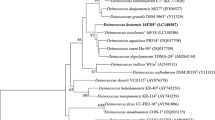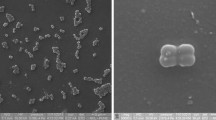Abstract
An aerobic, oligotrophic, Gram-positive, non-sporulating, motile, rod-shaped, palladium-leaching bacterial strain, Deinococcus sp. KR-1, was previously isolated from pond water collected in Japan. This strain grew at 10 °C to 40 °C (optimum 30 °C), at pH 4.5 to 11.5 (optimum pH 8.0), and in the presence of 2.0% NaCl. Its major cellular fatty acids were C15: 1ω6 and C16 : 1ω7c. The quinone system was menaquinone 8. Multilocus sequence analysis based on partial sequences of four housekeeping genes (atpD, dnaA, gyrB and rpoB) showed that branching of Deinococcus sp. KR-1 was distant to those of Deinococcus type strains. The genome average nucleotide identity value between strain KR-1 and its closest related Deinococcus type strain was less than 95.69%. Based on its phenotypic, chemotaxonomic and phylogenetic data, strain KR-1 (= HUT-8138T = KCTC 33977T) can be considered a novel species within the genus Deinococcus with the proposed name Deinococcus kurensis sp. nov.

Similar content being viewed by others
References
Akita H, Itoiri Y, Kumagai A, Takeda N, Matsushika A, Oshiki M, Kimura Z (2019) Draft genome sequence of Deinococcus sp. KR-1, a potential strain for palladium-leaching. J Genomics 8:21–24
Bligh EG, Dyer WJ (1959) A rapid method of total lipid extraction and purification. Can J Biochem Physiol 37:911–917
Brooks BW, Murray RGE (1981) Nomenclature for ‘‘Micrococcus radiodurans’’ and other radiation-resistant cocci: Deinococcaceae fam. nov. and Deinococcus gen. nov., including five species. Int J Syst Evol Microbiol 31:353–360
Brady C, Cleenwerck I, Venter S, Coutinho T, De Vos P (2013) Taxonomic evaluation of the genus Enterobacter based on multilocus sequence analysis (MLSA): proposal to reclassify E. nimipressuralis and E. amnigenus into Lelliottia gen. nov. as Lelliottia nimipressuralis comb. nov. and Lelliottia amnigena comb. nov., respectively, E. gergoviae and E. pyrinus into Pluralibacter gen. nov. as Pluralibacter gergoviae comb. nov. and Pluralibacter pyrinus comb. nov., respectively, E. cowanii, E. radicincitans, E. oryzae and E. arachidis into Kosakonia gen. nov. as Kosakonia cowanii comb. nov., Kosakonia radicincitans comb. nov., Kosakonia oryzae comb. nov. and Kosakonia arachidis comb. nov., respectively, and E. turicensis, E. helveticus and E. pulveris into Cronobacter as Cronobacter zurichensis nom. nov., Cronobacter helveticus comb. nov. and Cronobacter pulveris comb. nov., respectively, and emended description of the genera Enterobacter and Cronobacter. Syst Appl Microbiol 36:309–319
Brady C, Cleenwerck I, Venter S, Vancanneyt M, Swings J, Coutinho T (2008) Phylogeny and identification of Pantoea species associated with plants, humans and the natural environment based on multilocus sequence analysis (MLSA). Syst Appl Microbiol 31:447–460
Cha S, Srinivasan S, Seo T, Kim MK (2014) Deinococcus soli sp. nov., a gamma-radiation-resistant bacterium isolated from rice field soil. Curr Microbiol 68:777–783
Felsenstein J (1981) Evolutionary trees from DNA sequences: a maximum likelihood approach. J Mol Evol 17:368–376
Gordon RE, Barnett DA, Handerhan JE, Pang CHN (1974) Nocardia coeliaca, Nocardia autotrophica, and the nocardin strain. Int J Syst Bacteriol 24:54–63
Goris J, Konstantinidis KT, Klappenbach JA, Coenye T, Vandamme P, Tiedje JM (2007) DNA–DNA hybridization values and their relationship to whole-genome sequence similarities. Int J Syst Evol Microbiol 57:81–91
Graedel TE, Harper EM, Nassar NT, Nuss P, Reck BK (2015) Criticality of metals and metalloids. Proc Natl Acad Sci USA 112:4257–4262
Katoh K, Standley DM (2013) MAFFT multiple sequence alignment software version 7: improvements in performance and usability. Mol Biol Evol 30:772–780
Lee D, Cha S, Jang JH, Seo T (2016) Deinococcus arenae sp. nov., a novel species isolated from sand in South Korea. Antonie Van Leeuwenhoek 109:1055–1062
Maiden MC, Bygraves JA, Feil E, Morelli G, Russell JE, Urwin R, Zhang Q, Zhou J, Zurth K, Caugant DA et al (1998) Multilocus sequence typing: a portable approach to the identification of clones within populations of pathogenic microorganisms. Proc Natl Acad Sci USA 95:3140–3145
Oyaizu H, Stackebrandt E, Schleifer KH, Ludwig W, Pohla H, Ito H, Hirata A, Oyaizu Y, Komagata K (1987) A radiation-resistant rod-shaped bacterium, Deinobacter grandis gen. nov., sp. nov., with peptidoglycan containing ornithine. Int J Syst Bacteriol 37:62–67
Price MN, Dehal PS, Arkin AP (2010) FastTree 2—approximately maximum-likelihood trees for large alignments. PLoS ONE 10:e9490
Richter M, Rosselló-Móra R (2009) Shifting the genomic gold standard for the prokaryotic species definition. Proc Natl Acad Sci USA 106:19126–19131
Sun JE, Jin LJ, Kang MS, Lim S, Jeong SW, Bit KE, Hwa JS, Srinivasan S, Kyum KM (2016) Deinococcus actinosclerus sp. nov., a novel bacterium isolated from soil of a rocky hillside. Int J Syst Evol Microbiol 66:1003–1008
United States Geological Survey (2016) Platinum-group metals statistics and information. Minerals Yearbook Platinum Group Metals
Yoon SH, Ha SM, Lim J, Kwon S, Chun J (2017) A large-scale evaluation of algorithms to calculate average nucleotide identity. Antonie Van Leeuwenhoek 110:1281–1286
Acknowledgements
We are grateful to all members of the Bio-conversion Research Group at our Institute [Research Institute for Sustainable Chemistry, National Institute of Advanced Industrial Science and Technology (AIST)] for their technical assistance and valuable discussion. Our work was supported by Grants from JSPS KAKENHI to H. Akita (19K15743) and to Z. Kimura (18H01574).
Author information
Authors and Affiliations
Corresponding author
Ethics declarations
Conflict of interest
The authors declare that they have no conflict of interest.
Ethical approval
This article does not contain any studies with human participants or animals performed by any of the authors.
Additional information
Communicated by Erko Stackebrandt.
Publisher's Note
Springer Nature remains neutral with regard to jurisdictional claims in published maps and institutional affiliations.
Rights and permissions
About this article
Cite this article
Akita, H., Itoiri, Y., Ihara, S. et al. Deinococcus kurensis sp. nov., isolated from pond water collected in Japan. Arch Microbiol 202, 1757–1762 (2020). https://doi.org/10.1007/s00203-020-01845-8
Received:
Revised:
Accepted:
Published:
Issue Date:
DOI: https://doi.org/10.1007/s00203-020-01845-8




